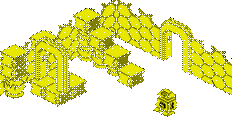A Review on GameFAQS.com
"The PlayStation Sensation."
The history of the console wars is a tale of hardship and massive bloodshed. In the mid-90's, the Super Nintendo was enjoying a nice, long run, and even though Nintendo's competitor, Sega, was already moving onto the world of 3-D gaming due to the Genesis stalling, the big N was content with taking its time and continuing with putting games in cartridge format. In enters electronics manufacturer Sony. Proposing a disc-based format for developing games, Sony offered a cheaper alternative and offered to assist Nintendo in manufacturing. But Nintendo's fatal flaw, perhaps even greater than developing the Virtual Boy, was turning down Sony's offer. From there, Sony decided to take matter into its own hands. Two years before the launch of its main rival, Nintendo 64, the PlayStation made its triumphant debut, complete with a plethora of bandwagon hoppers that had jumped ship from Nintendo due to Sony's cost-efficient methods. And while the system had a few technical shortcomings, it's nevertheless easy to see why the PlayStation was able to propel Sony to the top of the gaming market.
The PlayStation comes in two models – the original version and the more modern PSX model. Quite frankly, the original model is a clunky, unattractive, unreliable gray brick. For those of you who are not merely obsessive fanatics who collect every version of every system, the PSX is the infinitely superior model, appearing much sleeker and more portable. Yet the hardware still has some issues. The original model in particular has a tendency to overheat, while the system simply is not very durable, being susceptible to drops, so use caution when handling it. Disc errors are also a common problem I encountered no matter what game I was attempting to play. Fortunately, these shortcomings are balanced out by an incredibly reliable controller with a fantastic grip. The controller is suited for all types of games, featuring two analog sticks, a control pad, a variety of face and shoulder buttons, and most importantly, convenience. The third-party controllers are not quite as durable, however, so bear this fact in mind.
What made the PlayStation such a triumph, however, was not its hardware, but its immense game library. With companies such as Square, Capcom, Rockstar, and Konami aboard, the appeal of the PlayStation's game selection catered to all audiences. Perhaps most notable is its selection of RPG titles, mainly courtesy of Square. A trio of main entries in the Final Fantasy series lies here, in addition to countless spin-offs in the series. Other popular RPG titles include Xenogears, Chrono Cross (which I personally despise), Tales of Phantasia, The Legend of Dragoon, and Valkyrie Profile. But the other genres are not ignored. Action title fans will enjoy games such as Castlevania: Symphony of the Night and the first two Grand Theft Auto titles. Platform fans will crave the Spyro and Crash Bandicoot series (back when both series were good). Fighting game fans may prefer one of Sega's systems, but all other genre fans will be appeased here. The only real problem? Most games have completely unbearable loading times, which became a big problem with these early disc-based games. Nevertheless, these loading sequences only slightly bog down otherwise superb gaming experiences.
The PlayStation features a number of accessories, as well. In order to save any of your games, a memory card is a necessity, as this was before the age where disc data could conveniently be saved to a hard drive. The system can also play CDs, and it has a few gadgets and gizmos you can purchase separately to enhance your gaming experience. In regards to the system's visual department, the graphics outputted by the system are adequate, but much more grainy than those found on the Sega Saturn or Nintendo 64. Most early PlayStation titles in particular feature incredibly blocky and flat visuals that are anything but appeasing to the eye. This was also before anti-alias methods arrived, giving textures more jagged edges. However, the CD format does give the system's graphics one advantage over its cartridge-using competitors – the ability to play FMV movies in games. The PlayStation's audio is also aided by the disc format, giving the sounds and music a much sharper vibe. The one downside is that in this more primitive age of technology, the data could often not fit on a single disc, resulting in many multi-disc games.
What Sony's first attempt at a gaming console boils down to is a system that surpassed anybody's expectations at the time. Nintendo and Sega had been at each other's throats for half a decade, when all of a sudden a long shot arrives out of the blue and steals both companies' thunder. There are a few hardware issues, particularly with the original model, but it makes up for those shortcomings tremendously in the software department. The game library covers nearly every genre, making the system appeal to gamers of all varieties. The controller slips into anybody's grip perfectly, suiting any type of game flawlessly. And while the disc format features a few drawbacks, it ultimately worked to the system's advantage. Though the Nintendo 64 was superior in the technical department due to its later release, the cheaper development costs for the PlayStation ultimately helped it pull ahead in the end. Seeing as how Sony's future systems are backwards compatible, the need for searching out a PSX is not a necessity, but owners of any Sony console should no doubt check out some of this system's fantastic titles.
Reviewer's Score: 8/10, Originally Posted: 01/10/08
Game Release: PlayStation Hardware (US, 09/09/95)









